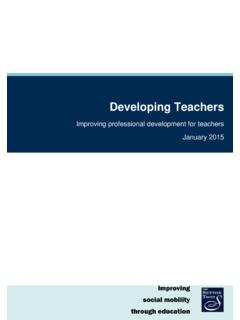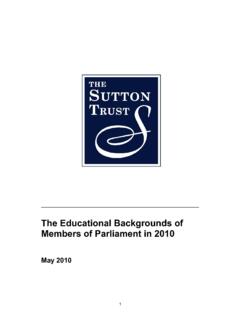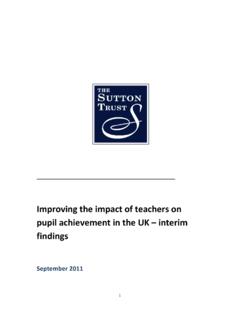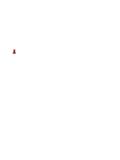Transcription of The Creation, Development and Present State of Grammar ...
1 1 the creation , Development and Present State of Grammar Schools in England Professor David Jesson University of York Centre for Performance Evaluation and Resource Management University of York York YO10 5DD United Kingdom 2013 David Jesson University of York. 2 1. An historical account of the Development of Grammar schools Competitive Selection for Grammar school education had long been seen as a natural part of the process by which schooling should be organised and scarce resources applied to support the maintenance of an administrative elite.
2 Whilst Grammar Schools have been a feature of the English education system at least since the time of Henry VIII, their emergence as an integral part of a fully-funded State compulsory education system offering Secondary Education for All only arose as a consequence of the 1944 Education Act which enshrined the role of selection as its principal instrument. The idea that each child had a fixed level of 'innate intelligence' which could be measured and presented as an Intelligence Quotient (IQ) score was widely promoted, most notably by psychologist Cyril Burt, who did more than anyone to advocate the widespread use of IQ tests 'for the purpose of pinning permanent labels on schoolchildren at the age of eleven' (Chitty, 2007).
3 Burt provided much of the theory on which the influential Hadow Reports of the 1930 s were based and wielded enormous influence over many years and, through the 1938 Spens Report1 contributed to the structure of the secondary education system that emerged in the wake of the 1944 Education Act2. Early Development of State -funded Grammar schools The Education Act of 1902 had set up Local Education Authorities to provide universal elementary education up to the age of 14 but which could also include the provision of secondary schools for bright children.
4 Secondary education was provided for a minority of able pupils in often newly created Grammar Schools. This was distinct from the elementary education provided for all other State -funded pupils. These Grammar Schools, like their independent counterparts, charged fees for the pupils they educated. However, the Education (Administrative Provisions) Act of 1907 required that all grant-aided secondary schools provide at least 25% of their places as free scholarships to pupils from public elementary schools.
5 Over the period from 1913 to 1937, the proportion of free places in secondary schools rose from around one third to just 1 Ministry of Education (1938) Report of the Consultative Committee on Secondary Education with special reference to Grammar Schools and Technical High Schools London. 2 (Gillard D (2008) Us and Them: a history of pupil grouping policies in England's schools see: ) 3 under one half. There were, however, substantial regional differences in provision and take-up and, more importantly, between different social classes.
6 Little and Westergaard s 1964 paper3 showed that over the period from the early 1900 s, whilst overall attendance at Grammar schools almost doubled, children admitted from semi-skilled and unskilled worker parental backgrounds increased from around 1% to 10%. Table : Social Class differentiation in admissions to Grammar schools Father s Occupation Pre 1910 1910 - 19 1920 - 29 1930 - 39 Professional, managerial 37% 47% 52% 62% Other non-manual 7% 13% 16% 20% Semi-skilled or unskilled 1% 4% 7% 10% All 12% 16% 18% 23% Data source.
7 The rate of increase in this period for pupils from the lowest classes was higher than for those from other classes however, the absolute gains were highest for those pupils with Professional and Managerial class parents, where admissions rose from just over one third to almost two thirds. Commenting on this Boudon (1973)4 reported that: From the point of view of individuals, the probability of attending Grammar school increased over this period much more rapidly for lower class than for higher class pupils.
8 But from the point of view of social groups from the beginning to the end of the period under review 100 higher class people have been able to send an additional 25 pupils to Grammar schools whereas this additional number was just 9 for the lower group This issue grew in importance over the next thirty years as the impact of reconstruction after World War II began to impact on society. The changes in structure of education subsequently brought about by the 1944 Education Act had been articulated by The Spens Report 5.
9 This sought to bring a degree of order into what was an increasingly diverse and confusing range of public education provision by setting out a framework for its future Development . Essentially this proposed a tripartite system which provided for universal education within primary and secondary phases, the secondary phase of which was to be tripartite in nature 3 Little, A, and Westergaard, J. (1964) Trends in Class Differentials in Educational Opportunity in England and Wales British Journal of Scociology, 15 1964.
10 4 Boudon, R. (1973) Education, Opportunity and Social Inequality New York John Wiley 5 Ibid. 4 comprising schools for academic pupils, technical/vocational schools and modern schools for the majority. The type of school a pupil attended was to be appropriate for their age, aptitude and ability and there was to be parity of esteem for each type of school. The full description of, and justification for the tripartite system of secondary education was provided in the Ministry of Education Pamphlet 9 (published in 1947) under the title The New Secondary Education.











